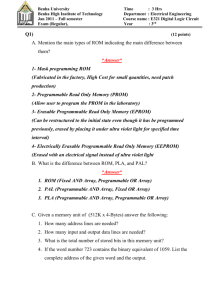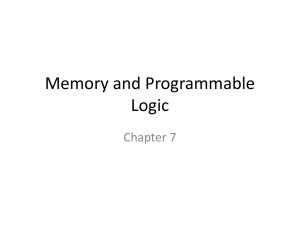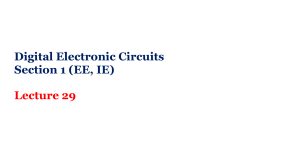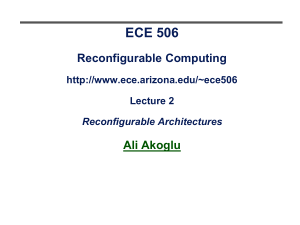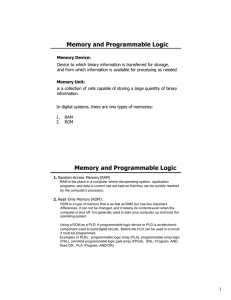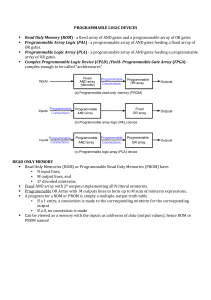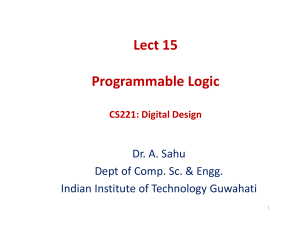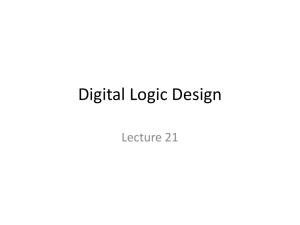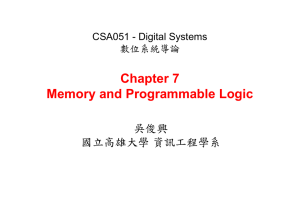Programmable Logic Device
advertisement
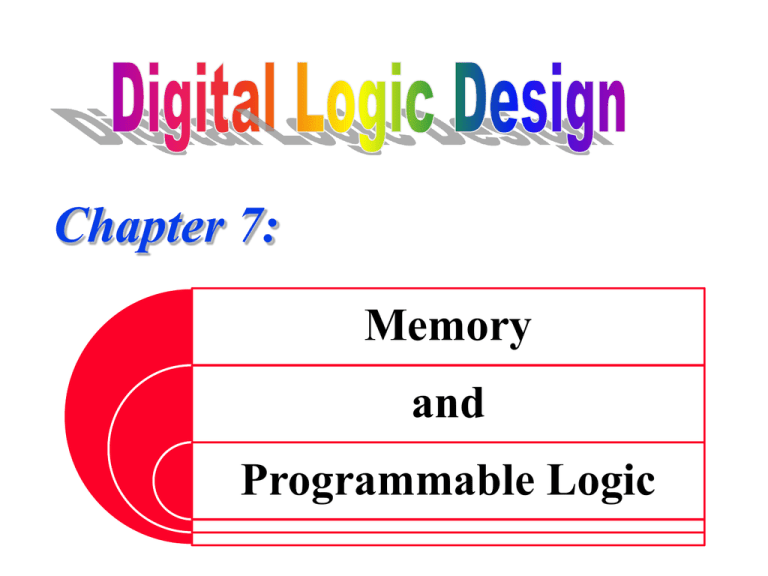
Chapter 7: Memory and Programmable Logic Random-Access Memory (RAM) Data Storage (Volatile) Data input Locations (Address) Byte or Word Address Memory unit Read Write 16 x 8 Data output 1 / 18 Random-Access Memory (RAM) Data Storage (Volatile) m Data input Locations (Address) Byte or Word 10 Address lines 1024 locations =1K k Address Memory unit Read Write 2k x m m Data output 2 / 18 Memory Decoding Memory Cell Select Input Output Read/Write Select Input BC S Q R Q Output Read/Write 3 / 18 Memory Decoding Memory Array Address Lines I1 I0 0 BC BC BC BC BC BC BC BC BC BC BC BC BC BC BC BC 1 2x4 Decoder 2 Memory Enable Input Data E 3 Read/Write Output Data 4 / 18 Read-Only Memory (ROM) k Address ROM Memory Enable 2k x m m Data output 5 / 18 Read-Only Memory (ROM) Conventional Symbol Array Logic Symbol 6 / 18 Read-Only Memory (ROM) 8 x 4 ROM Address Lines Memory Enable 3x8 Decoder I2 I1 I0 E 0 1 2 3 4 5 6 7 Output Data 7 / 18 Read-Only Memory (ROM) 3x8 Decoder 8 x 4 ROM Address 0 0 0 0 0 1 0 1 0 0 1 1 1 0 0 1 0 1 1 1 0 1 1 1 Data 0000 1101 0011 1000 1111 1001 0111 0000 A2 A1 A0 I2 I1 I0 1 E 0 1 2 3 4 5 6 7 D3 D2 D1 D0 8 / 18 Types of ROMs Mask Programmed ROM ● Programmed during manufacturing Programmable Read-Only Memory (PROM) ● Blow out fuses to produce ‘0’ Erasable Programmable ROM (EPROM) ● Erase all data by Ultra Violet exposure Electrically Erasable PROM (EEPROM) ● Erase the required data using an electrical signal 9 / 18 Programmable Logic Device (PLD) Boolean Functions: ● Sums-of-Products ● AND-plane followed by OR-plane Y7 Y6 Y5 Y4 Y3 Y2 Y1 Y0 I2 I1 I0 10 / 18 Programmable Logic Device (PLD) PROM Inputs Fixed AND array (Decoder) Programmable OR array Outputs Programmable AND array Fixed OR array Outputs Programmable AND array Programmable OR array Outputs PAL Inputs PLA Inputs 11 / 18 Programmable Array Logic (PAL) 1 2 3 4 5 6 7 8 9 10 Example 1 w(A,B,C,D) = ∑(2,12,13) x(A,B,C,D) = ∑(7,8,9,10,11,12,13,14,15) 2 F1 w F2 x F3 y F4 z 3 A I1 y(A,B,C,D) = ∑(0,2,3,4,5,6,7,8,10,11,15) 4 z(A,B,C,D) = ∑(1,2,8,12,13) 5 6 Simplify: B I2 7 w = ABC’ + A’B’CD’ 8 x = A + BCD y = A’B + CD + B’D’ 9 C I3 z = ABC’ + A’B’CD’ + AC’D’ + A’B’C’D 10 11 = w + AC’D’ + A’B’C’D 12 D I4 1 2 3 4 5 6 7 8 9 10 12 / 18 Programmable Logic Array (PLA) A I1 B I2 C I3 Example: 0 1 F1 = AB’ + AC + A’BC’ F1 F2 = (AC + BC)’ F2 13 / 18 Sequential Programmable Logic Device Basic Macrocell Logic CLK OE D Q ENB Q 14 / 18 Homework Mano ● Chapter 7 ♦ 7-1 ♦ 7-2 ♦ 7-3 ♦ 7-18 ♦ 7-19 15 / 18 Homework 7-1 The following memory units are specified by the number of words times the number of bits per word. How many address lines and input-output lines are needed in each case? (a) 4K 16, (b) 2G 8, (c) 16M 32, (d) 256K 64. 7-2 Give the number of bytes stored in the memories listed in Problem 7-1. 7-3 Word number 723 in a memory of 1024 16 contains the binary equivalent of 3,451. List the 10-bit address and the 16-bit memory content of the word. 16 / 18 Homework 7-18 Specify the size of a ROM (number of words and number of bits per word) that will accommodate the truth table for the following combinational circuit components: (a) a binary multiplier that multiplies two 4-bit, (b) a 4-bit adder-subtractor, (c) a quadruple 2-to-1-line multiplexers with common select and enable inputs, and (d) a BCD-to-seven-segment decoder with an enable input. 17 / 18 Homework 7-19 Tabulate the truth table for an 8 4 ROM that implements the Boolean functions A(x,y,z) = ∑(1,2,4,6) B(x,y,z) = ∑(0,1,6,7) C(x,y,z) = ∑(2,6) D(x,y,z) = ∑(1,2,3,5,7) 18 / 18
